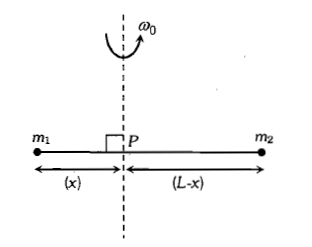One solid sphere A and another hollow sphere B are of same mass and same outer radii. Their moment of inertia about their diameters are respectively IA and IB such that
1.
2.
3.
4.
A couple produces:
1. purely linear motion
2. purely rotational motion
3. linear and rotational motion
4. no motion
A wheel of radius R rolls on the ground with a uniform velocity v. The velocity of topmost point relative to the bottommost point is
1. v
2. 2v
3. v/2
4. zero
A constant torque of 1000 N-m turns a wheel of moment of inertial 200 about an axis through its centre. Its angular velocity after 3 s is
1. 1 rad/s
2. 5 rad/s
3. 10 rad/s
4. 15 rad/s
Point masses and are placed at the opposite ends of a rigid of length L and negligible mass. The rod is to be set rotating about an axis perpendicular to it. The position of point P on this rod through which the axis should pass so that the work required to set the rod rotating with angular velocity is minimum is given by

A wheel is at rest. Its angular velocity increases uniformly and becomes \(80\) rad/s after \(5\) s. The total angular displacement is
| 1. | \(800\) rad | 2. | \(400\) rad |
| 3. | \(200\) rad | 4. | \(100\) rad |
Two discs are rotating about their axes, normal to the discs and passing through the centres of the discs. Disc D has a 2 kg mass, 0.2 m radius, and an initial angular velocity of 50 rad s. Disc D has 4 kg mass, 0.1 m radius, and initial angular velocity of 200 rad s. The two discs are brought in contact face to face, with their axes of rotation coincident. The final angular velocity (in rad.s) of the system will be:
1. 60
2. 100
3. 120
4. 40
A body rolls down an inclined plane without slipping. The fraction of total energy associated with its rotation will be
Where k is radius of gyration of the body about an axis passing through centre of mass and R is the radius of the body.
A solid cylinder rolls down an inclined plane that has friction sufficient to prevent sliding. The ratio of rotational energy to total kinetic energy is
1.
2.
3.
4.






